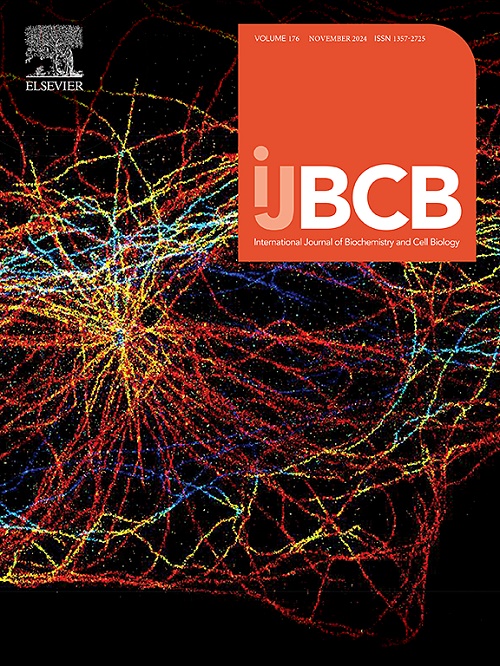杂合子Kctd5敲除小鼠表现出异常的脂质代谢
IF 2.8
3区 生物学
Q2 BIOCHEMISTRY & MOLECULAR BIOLOGY
International Journal of Biochemistry & Cell Biology
Pub Date : 2025-08-20
DOI:10.1016/j.biocel.2025.106851
引用次数: 0
摘要
KCTD基因家族是跨物种保守的,但对其功能的了解有限。近年来,对KCTD5的研究越来越多。揭示了KCTD5的功能及其与多种疾病的关系。然而,KCTD5在体内的功能仍然是未知的。我们使用CRISPR/Cas9技术生成了Kctd5基因外显子2缺失的Kctd5+/-小鼠。Kctd5+/-小鼠的育种实验表明,只有Kctd5+/-和Kctd5+/+小鼠能够正常出生,而Kctd5-/-胚胎在胚胎发育早期死亡。与Kctd5+/+小鼠相比,Kctd5+/-小鼠寿命较短,脾脏肿大,血细胞计数异常,代谢紊乱,包括胆固醇和甘油三酯水平升高。全基因组基因表达分析显示,KCTD5可能影响PPAR信号通路,进而影响Apo家族基因的表达,从而调节脂质代谢。综上所述,我们的研究发现了KCTD5在调节脂质代谢和KCTD5缺陷诱导的动物表型中的先前未被认识到的作用,并揭示了KCTD5与小鼠各种分子之间的多重相关性。本文章由计算机程序翻译,如有差异,请以英文原文为准。
Heterozygous Kctd5 knockout mice exhibit abnormal lipid metabolism
The KCTD gene family is conserved across species, yet the knowledge of its function is limited. Recently, increasing studies focused on KCTD5 emerged. The functions of KCTD5 and its associations with various diseases were revealed. However, the function of KCTD5 in vivo has remained elusive. We generated Kctd5+/- mice with the Kctd5 gene’s exon 2 deleted using CRISPR/Cas9 technology. Breeding experiments on Kctd5+/- mice showed that only Kctd5+/- and Kctd5+/+ mice could be born normally, while Kctd5-/- embryos died in early embryonic development. Compared to Kctd5+/+ mice, Kctd5+/- mice have a shorter lifespan and exhibit spleen enlargement, abnormal blood cell counts, and metabolic disorders, including elevated cholesterol and triglyceride levels. Genome-wide gene expression analysis revealed that KCTD5 may affect the PPAR signaling pathway and subsequent the expression of Apo family genes, thereby regulating lipid metabolism. In summary, our study identified a previously unrecognized role of KCTD5 in regulating lipid metabolism and KCTD5 deficiency-induced animal phenotype, and revealed multiple correlations between KCTD5 and various molecules in mice.
求助全文
通过发布文献求助,成功后即可免费获取论文全文。
去求助
来源期刊
CiteScore
8.10
自引率
0.00%
发文量
124
审稿时长
19 days
期刊介绍:
IJBCB publishes original research articles, invited reviews and in-focus articles in all areas of cell and molecular biology and biomedical research.
Topics of interest include, but are not limited to:
-Mechanistic studies of cells, cell organelles, sub-cellular molecular pathways and metabolism
-Novel insights into disease pathogenesis
-Nanotechnology with implication to biological and medical processes
-Genomics and bioinformatics

 求助内容:
求助内容: 应助结果提醒方式:
应助结果提醒方式:


